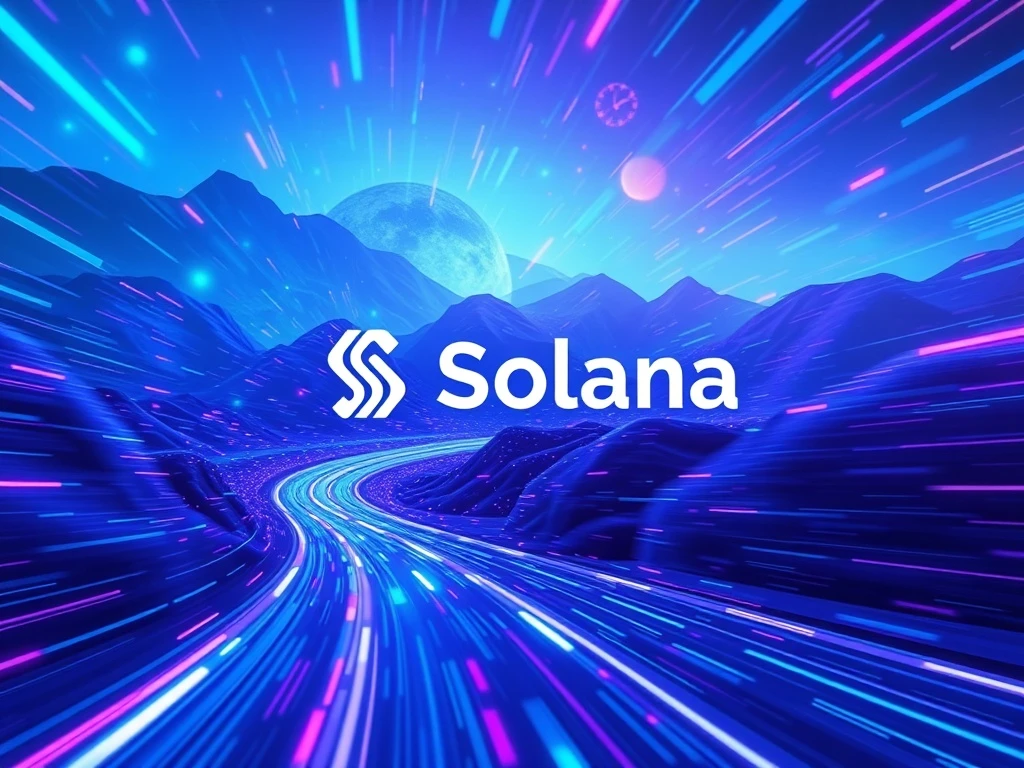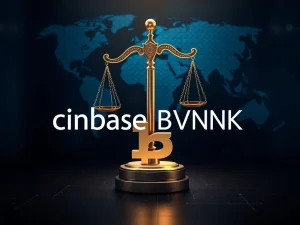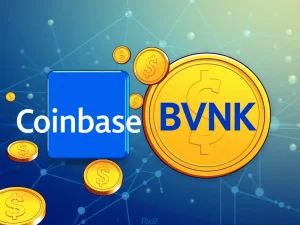Solana Alpenglow: Revolutionary Upgrade Promises Unprecedented Speed, Faster Than Google

The cryptocurrency world often debates the future of blockchain technology. Many projects vie for dominance, but Solana Alpenglow now emerges as a potential game-changer. This ambitious Solana upgrade aims to set new benchmarks for speed and efficiency. Indeed, it could make crypto transactions feel instantaneous, surpassing even traditional internet services. Consequently, the upgrade seeks to redefine user expectations for decentralized applications.
Unlocking Unprecedented Solana Speed
Solana has consistently positioned itself as a high-performance blockchain. Now, with the imminent Solana Alpenglow upgrade, it prepares for a monumental leap. Validators overwhelmingly approved this crucial network enhancement. In fact, nearly 99% of the network supported the proposal. If implemented successfully, Alpenglow will dramatically reduce blockchain finality. Currently, transactions finalize in approximately 12.8 seconds. The upgrade targets an astonishing 100 to 150 milliseconds. This represents a nearly hundredfold increase in speed. To clarify, this speed rivals common internet benchmarks. A typical Google search, for instance, averages about 200 milliseconds. Payment giants like Visa process card transactions in a similar timeframe. Therefore, if Solana achieves this window, blockchain applications could feel indistinguishable from traditional systems. This shift truly redefines user interaction with crypto. Ultimately, it could unlock a new era for decentralized finance.
Solana’s Competitive Edge in Blockchain Finality
Before Alpenglow, Solana already held a strong position among fast blockchains. Its 12.8-second finality outpaces Ethereum’s typical 12-second inclusion and 12-minute true finality. Other performance-focused Layer-1 chains also lag behind Alpenglow’s targets. Sui, for example, offers around 400-millisecond finality. While impressive, this is still more than double Alpenglow’s projected speed. The successful delivery of this Solana upgrade could fundamentally reshape the competitive landscape. High-frequency applications critically need sub-second finality. This includes decentralized exchanges (DEXs), derivatives platforms, and blockchain-based games. Users often experience lag in many Web3 systems. However, Alpenglow promises an experience much closer to Web2’s immediacy. Interestingly, CoinGecko Research reported that Solana captured 38% of global crypto investor interest in chain-specific narratives during 2024. This figure significantly surpassed Ethereum’s 10%.
Inside the Alpenglow Governance Vote
The governance process for the Solana Alpenglow upgrade demonstrated strong community consensus. It commenced on August 21, 2025, spanning epochs 840 through 842. Participation was robust from the start. Validators and stakers quickly met the 33% quorum requirement. This ensured the proposal moved forward without delay. As ballots arrived, support proved overwhelming. Early counts showed backing between 99.6% and 99.7%. Only a tiny fraction of participants voted against the measure. By the close of the vote on September 4, 2025, 98.94% of all participating stakeholders had approved it. Approximately 0.5% opposed the upgrade, and another almost half-percent abstained. Crucially, participation reached about 52% of the network’s total stake. This comfortably exceeded the minimum threshold. It also suggested broad legitimacy for the proposal. Such near-unanimity is rare in decentralized governance. Often, divisions emerge even on technical upgrades. For Solana, the outcome clearly shows stakeholder alignment on Alpenglow’s necessity. This widespread support reinforces confidence in the Solana upgrade.
The Core Mechanics of the Solana Alpenglow Upgrade
At its heart, Solana Alpenglow introduces two innovative architectural components: Votor and Rotor. These systems fundamentally redesign how Solana processes and finalizes transactions. They enable the chain to confirm blocks within 100-150 milliseconds. The upgrade facilitates faster consensus. It achieves this without compromising crucial security guarantees. Previously, the network waited for multiple rounds of validator communication. Now, the process becomes significantly more efficient. Beyond speed, Alpenglow also implements a new economic model. Validator Admission Tickets (VATs) aim to streamline validator onboarding. They also seek to reduce operational costs for participants. Furthermore, the upgrade includes the ’20/20′ resilience model. This model allows the network to tolerate up to 20% of validators failing. It also accommodates another 20% behaving maliciously. Thus, Solana gains enhanced robustness against disruptions. Building decentralized finance (DeFi) platforms, trading engines, or multiplayer games becomes more feasible. Users will no longer endure awkward delays. Transactions could feel truly instant. This will likely unlock new use cases previously requiring centralized infrastructure. These advancements solidify Solana’s position as a leader in blockchain finality.
Addressing Risks and Enhancing Solana’s Resilience
While Solana Alpenglow offers extraordinary promise, the upgrade does not eliminate all existing concerns. The network still heavily relies on Agave, its primary validator client. A single bug or exploit in this client could impact the entire ecosystem. However, a significant solution is on the horizon. Firedancer, a second validator client built by Jump Crypto, will debut on the mainnet later this year. Firedancer will diversify the network’s software base. This diversification will drastically improve resilience. Multiple independent clients are standard in other major ecosystems. Ethereum, for instance, utilizes Geth, Nethermind, Besu, and Erigon. Therefore, Solana’s current reliance on one client remains a potential vulnerability. This will change once Firedancer becomes fully operational. Questions about centralization also persist. While VATs and cost reductions aim to lower entry barriers, some critics voice concerns. They argue that fixed-tier fees and fault-tolerance thresholds might favor larger validators. These entities possess deeper resources. If this dynamic unfolds, the network risks exchanging one bottleneck (speed) for another (concentration of power). Researchers recently identified specialized phishing techniques, dubbed ‘SolPhish,’ targeting Solana users. These attacks have led to $1.1 million in losses. In response, they developed SolPhishHunter, a pioneering detection tool for the ecosystem. This tool highlights ongoing efforts to secure crypto transactions.
Beyond Speed: Unlocking New Possibilities with Solana’s Alpenglow
The headline figure of 150 milliseconds certainly captures attention. However, the true significance of Solana Alpenglow lies in what this speed enables. Consider decentralized exchanges (DEXs). Today, even top DeFi platforms struggle to match the responsiveness of centralized order books. Market conditions can shift considerably before a transaction clears. With Alpenglow, order books could update in real-time. This offers traders the fluid experience expected from centralized platforms. Crucially, it does so without sacrificing self-custody. The benefits extend even more clearly to gaming. Blockchain-based games often falter when interactions lag. Long confirmation windows also hinder gameplay. Sub-second blockchain finality could make in-game economies seamless. This applies whether trading items, earning rewards, or settling bets. Moreover, Alpenglow represents a breakthrough for payments. Sending stablecoins across borders in 150 milliseconds would place crypto payments on par with credit card networks. Combined with Solana’s inherently low fees, the Solana upgrade positions the network as a genuine alternative for real-time settlement. This transformation significantly enhances the utility of crypto transactions.
Enterprise-Grade Infrastructure and Institutional Trust in Solana
Sub-second blockchain finality, coupled with stronger resilience mechanisms, makes Solana highly appealing to businesses. Enterprises cannot afford downtime. The ’20/20′ resilience model also reassures players concerned about network stability. Existing numbers already indicate growing institutional trust. Three publicly listed companies have collectively staked approximately $1.7 billion on Solana. This demonstrates significant confidence in its long-term stability. Beyond staking, the ecosystem continues to broaden. Tokenized real-world assets (RWAs) on Solana now total roughly $390 million. Meanwhile, total value locked (TVL) has climbed past $8.6 billion. Staking yields, averaging about 7%, also fuel demand for new investment products. Exchange-traded funds (ETFs) tied to Solana (SOL) record millions in inflows. Solana is moving well beyond retail adoption and speculation. It is positioning itself as robust infrastructure. This infrastructure is capable of supporting enterprise-level finance. Major financial entities, including HSBC, Bank of America, Euroclear, and the Monetary Authority of Singapore, are integrating Solana. They do this into their tokenization efforts. This happens via a strategic partnership with R3. This shows a profound shift in perception for the Solana upgrade.
The Road Ahead for Solana’s Speed and Security
With governance now finalized, Solana’s roadmap is firmly in motion. A testnet deployment of Solana Alpenglow is scheduled for December 2025. This will occur at the Breakpoint conference. The mainnet upgrade will follow in Q1 2026. In parallel, Firedancer continues its phased rollout. As of mid-2025, it already operates in a hybrid ‘Frankendancer’ mode on over 10% of validators. It has also demonstrated throughput exceeding 1 million crypto transactions per second in testing. Firedancer represents a decisive step toward client diversity. For Solana, the stakes are exceptionally high. It aims for sub-100 millisecond finality. Simultaneously, it must ensure resilience against single-client risk. If successful, the combination of Alpenglow and Firedancer will solidify Solana’s performance edge. This applies especially to high-throughput applications. Together, these updates will provide a more inclusive foundation. This benefits smaller validators and developers alike. Ultimately, it strengthens the ecosystem’s long-term credibility and secures its future as a leading blockchain. The continuous pursuit of improved Solana speed remains a core objective.







